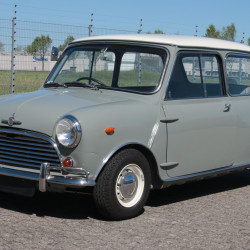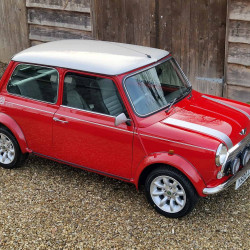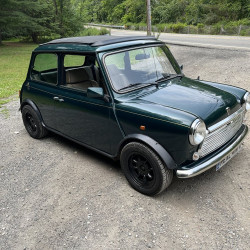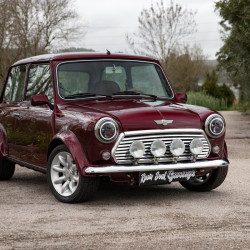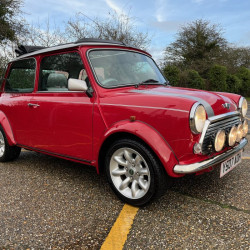USD 93,526.00
Contact Information
Phone: +44 1242384092
E-Mail: info@classicmotorhub.com
Address: Open In New Tab
Summary
Location: United Kingdom / London
Year Of Manufacture: 1959
Mileage: 1 mil / 1 km
SPECIFICATIONS
- Year Of Manufacture: 1959
- Mileage: 1 mil / 1 km
- Car Type: Coupe
- Drive: N/A
- Condition: Restored
- Interior Colour: Black
- Number Of Doors: 2
- Number Of Seats: 1
- Location: United Kingdom / London
- Exterior Colour: Grey
- Gearbox: Manual
- Performance: 125 BHP
- Drivetrain: 2wd
- Fuel Type: Petrol
DESCRIPTION
- FIA Specification Racing Mini
- Zero-hour Nick Swift engine and gearbox
- TIG welded custom roll cage
- Current FIA papers
- Nick Swift suspension and fuel cell
Originally built and prepared for competition by Welsh specialist Owens Fabrication, this Mini Cooper S features a zero-hour engine and gearbox by A-series guru Nick Swift. The history of Swiftune goes back to the 1960s, when it was founded by Glyn Swift, and the company has built a stellar reputation in historic racing thanks to extensive success in high-profile events such as the Goodwood Revival.
This beautifully presented Mini Cooper S is every inch the focused racing machine, with a fully stripped bodyshell and a driver’s seat that is set well back and as low as possible in order to optimise the centre of gravity. The original speedometer is surrounded by a Stack rev counter and modern dials for the water temperature and oil pressure.
A small box where the passenger seat would normally be features controls for the ignition, fuel and starter, as well as heater, headlamps and windscreen wipers. There’s also a TIG-welded custom roll cage and a plumbed-in fire-extinguisher system. Open the boot and you’ll be greeted by the sight of a Swiftune fuel cell, and the suspension is also courtesy of Swiftune. The wheels are shod with 5.00 x 10 Dunlop Racing tyres.
This racing Mini Cooper S competed in the 2019 Silverstone Classic, where it was driven by Ben Seyfried in the Mini Celebration Trophy, which marked the groundbreaking little car’s 60th anniversary. Now being offered for sale by The Classic Motor Hub, it has current FIA papers and is eligible for a number of historic series, where Minis never fail to captivate spectators with their giant-killing antics.
Built to the very highest specification using only the best components and specialists, it will be competitive straight out of the box and there’s surely no more entertaining way to go motor racing.
MODEL HISTORY
When it was launched in 1959, the Mini set the template for all subsequent compact cars thanks to its use of a transversely mounted engine driving the front wheels. Alec Issigonis’s design was a work of packaging genius and offered an impressive amount of interior space in such a small car, but over time it became more than just an engineering achievement. It became a potent symbol of the Swinging Sixties, and a genuine cultural icon.
Originally launched under the Morris and Austin brands, the Mini was intended to offer affordable no-frills motoring, but it wasn’t long before enthusiastic drivers began to see its sporting potential. John Cooper – boss of the eponymous Formula One team – was one of them, and he convinced Issigonis and BMC to fit a 997cc engine with twin carburettors, a closer-ratio gearbox and front disc brakes. The result was the legendary Mini Cooper, which appeared in 1961.
That was followed in 1963 by the Mini Cooper S, with further modifications including a 1071cc engine. There was also the option of a 970cc or 1275cc Cooper S, and the British pocket rocket became a force to be reckoned with in international motor sport. It won the Monte-Carlo Rally in 1964, 1965 and 1967 – courtesy of Paddy Hopkirk, Timo Mäkinen and Rauno Aaltonen – and only missed out in 1966 because it was controversially disqualified.
Minis won the British Saloon Car Championship five times, the British Rally Championship three times, the European Rally Championship twice, and the European Touring Car Championship twice. What it lacked in straight-line speed, it more than made up for with its roadholding and manoeuvrability, and Minis remained competitive right through the 1960s.
Those qualities are still much in evidence in today’s historic racing, with spectators revelling in the sight of a Mini buzzing past much larger machinery and proving the old adage that less is more.
- Zero-hour Nick Swift engine and gearbox
- TIG welded custom roll cage
- Current FIA papers
- Nick Swift suspension and fuel cell
Originally built and prepared for competition by Welsh specialist Owens Fabrication, this Mini Cooper S features a zero-hour engine and gearbox by A-series guru Nick Swift. The history of Swiftune goes back to the 1960s, when it was founded by Glyn Swift, and the company has built a stellar reputation in historic racing thanks to extensive success in high-profile events such as the Goodwood Revival.
This beautifully presented Mini Cooper S is every inch the focused racing machine, with a fully stripped bodyshell and a driver’s seat that is set well back and as low as possible in order to optimise the centre of gravity. The original speedometer is surrounded by a Stack rev counter and modern dials for the water temperature and oil pressure.
A small box where the passenger seat would normally be features controls for the ignition, fuel and starter, as well as heater, headlamps and windscreen wipers. There’s also a TIG-welded custom roll cage and a plumbed-in fire-extinguisher system. Open the boot and you’ll be greeted by the sight of a Swiftune fuel cell, and the suspension is also courtesy of Swiftune. The wheels are shod with 5.00 x 10 Dunlop Racing tyres.
This racing Mini Cooper S competed in the 2019 Silverstone Classic, where it was driven by Ben Seyfried in the Mini Celebration Trophy, which marked the groundbreaking little car’s 60th anniversary. Now being offered for sale by The Classic Motor Hub, it has current FIA papers and is eligible for a number of historic series, where Minis never fail to captivate spectators with their giant-killing antics.
Built to the very highest specification using only the best components and specialists, it will be competitive straight out of the box and there’s surely no more entertaining way to go motor racing.
MODEL HISTORY
When it was launched in 1959, the Mini set the template for all subsequent compact cars thanks to its use of a transversely mounted engine driving the front wheels. Alec Issigonis’s design was a work of packaging genius and offered an impressive amount of interior space in such a small car, but over time it became more than just an engineering achievement. It became a potent symbol of the Swinging Sixties, and a genuine cultural icon.
Originally launched under the Morris and Austin brands, the Mini was intended to offer affordable no-frills motoring, but it wasn’t long before enthusiastic drivers began to see its sporting potential. John Cooper – boss of the eponymous Formula One team – was one of them, and he convinced Issigonis and BMC to fit a 997cc engine with twin carburettors, a closer-ratio gearbox and front disc brakes. The result was the legendary Mini Cooper, which appeared in 1961.
That was followed in 1963 by the Mini Cooper S, with further modifications including a 1071cc engine. There was also the option of a 970cc or 1275cc Cooper S, and the British pocket rocket became a force to be reckoned with in international motor sport. It won the Monte-Carlo Rally in 1964, 1965 and 1967 – courtesy of Paddy Hopkirk, Timo Mäkinen and Rauno Aaltonen – and only missed out in 1966 because it was controversially disqualified.
Minis won the British Saloon Car Championship five times, the British Rally Championship three times, the European Rally Championship twice, and the European Touring Car Championship twice. What it lacked in straight-line speed, it more than made up for with its roadholding and manoeuvrability, and Minis remained competitive right through the 1960s.
Those qualities are still much in evidence in today’s historic racing, with spectators revelling in the sight of a Mini buzzing past much larger machinery and proving the old adage that less is more.

